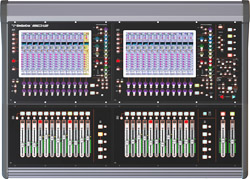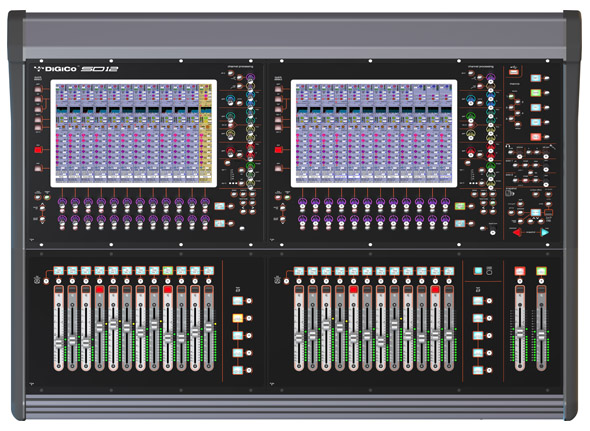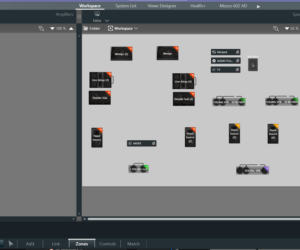DiGiCo has introduced the SD12, a compact digital console utilizing the latest generation of Super FPGA technology. It is on display at the NAMM show this week in Anaheim.
The SD12 has 72 input channels with full processing, 36 aux/group buses with full processing, a 12 x 8 matrix with full processing, LR/LCR bus with full processing, 12 stereo FX units, 16 graphic EQs, 119 dynamic EQs, 119 multiband compressors and 119 DiGi-TuBes, 12 control groups (VCA) and SD Series Stealth Core 2 software, making it compatible with all other SD Series sessions.
The SD12 is also outfitted with dual 15-inch digital touch screens –- previously only seen on the SD7 and SD5—which provide 24 channels in one view, dual operator mode and the ability for the right-hand screen to be the master, as well as advanced connectivity via optional DMI cards.
EQ and dynamics controls are aligned next to both the left and right-hand screens, so that they sit adjacent to the graphic representation that is seen when assigning an EQ. DiGiCo has also included its proprietary Hidden Til Lit (HTL) technology, with two banks of 24 encoders featuring an RGB HTL ring as well as an SD7-style channel strip with HTL EQ encoders.
There is also new Dynamics metering on the channel strip and new high-intensity meters associated with the faders. The rotaries that sit below the screen indicate, by color, what parameters they are controlling to allow for fast operation; these are also HTL.
The addition of gain reduction meters normally only seen on the SD7 and SD5 and metering to show the action of the gates making the feedback from the worksurface unrivaled at its price point.
There is also an assignable master section on the bottom right hand side of the work surface, and two assignable faders with their own displays and metering, which can be assigned to be any of the channels whether input or output, or solo master controls.
Dedicated RGB scribble strips, of which there are five, can be assigned to macros with five banks giving a total of 25 macros, and there is a snapshot panel for quickly accessing and controlling the snapshots list, as well as for firing the next and previous snapshot.
On the back of the console, there are eight local mic/line inputs, eight local line outputs and eight AES/EBU in/out for local digital sources, as well as two MADI ports, plus a UB MADI connection for recording at 48 kHz; 48 tracks of recording are possible with the console clocking at 48 kHz and 24 tracks if it is clocking at 96 kHz.
There are two slots for DMI cards. Options include a Dante module, which can be plugged straight into the back of the console, alleviating the need to purchase an Orange Box. A Waves module can also be fitted to take advantage of the SoundGrid platform. There is a large family of DMI cards that can be plugged in the SD12, which can be changed between different projects or tours, depending on requirements.
And, the SD12 has a suite of remote control options, including the iPad SD remote app which offers remote control, expansion and show control. Offline software, meanwhile, allows for session preparation and online remote. There are OSC and Ross network protocols; 16 pin GPIO that allows for audio follows video and show control; Serial/MIDI in/out for MMC/MTC, MIDI remote and QLab; second console mirroring and redundancy.
Finally, there is also the option to upgrade straight into the Optocore network with not one, but two loop options, allowing the SD12 to sit anywhere on a loop with any other Optocore-enabled SD product.
“The SD12 has already created an international impact, with over 30 of our distributors taking part in a surprise global launch, details to follow shortly,” says DiGiCo MD James Gordon. “The SD12 takes all the true DiGiCo values and installs them into a compact, cost-effective surface with unrivaled feedback and control. It is ideal for operators that demand the best audio quality, combined with an intuitive and fast multi-screen worksurface.”
SD12 Overview:
—72 input channels with full processing
—36 aux/group buses with full processing
—12 x 8 matrix with full processing
—LR/LCR bus with full processing
—12 FX fully assignable processors
—16 graphic EQs
—119 dynamic EQs,
—119 multiband compressors
—119 DiGiTuBes
—12 control groups (VCA)
—SD Series Stealth Core 2 software, making it compatible with all other SD Series sessions
—8 local mic/line inputs
—8 local line outputs
—8 AES/EBU in/out
—Dual MADI in/out
—Dual DMI card slots
—Optional dual Optocore loops
—UB MADI 48-channel USB interface
—16 GPI/GPO, MIDI, wordclock in/out
—Overview monitor output, USB and network
—User configurable busing and flexible layout
—Snapshot automation
—Virtual sound check and copy audio matrix
—Full dynamic EQ, DiGi-TuBes and multiband compression on every processing strip. full function channels across the entire console, whether it is an output or input
—Free offline software and iPad app
—SD11/9/5 style quick select
—SD5/SD7 light bar
—25 user-definable macro buttons
















